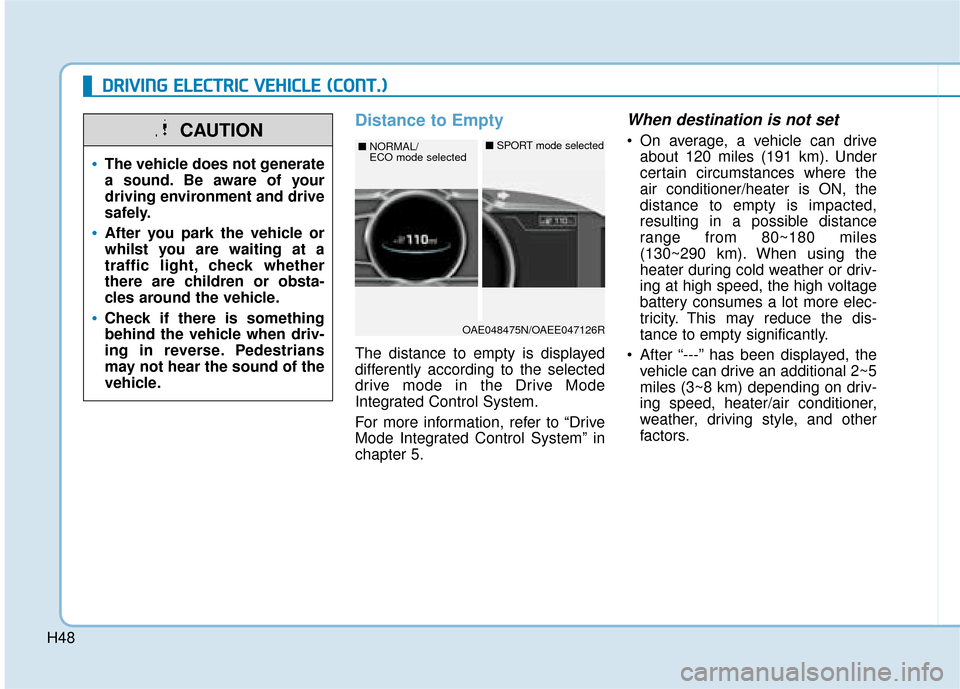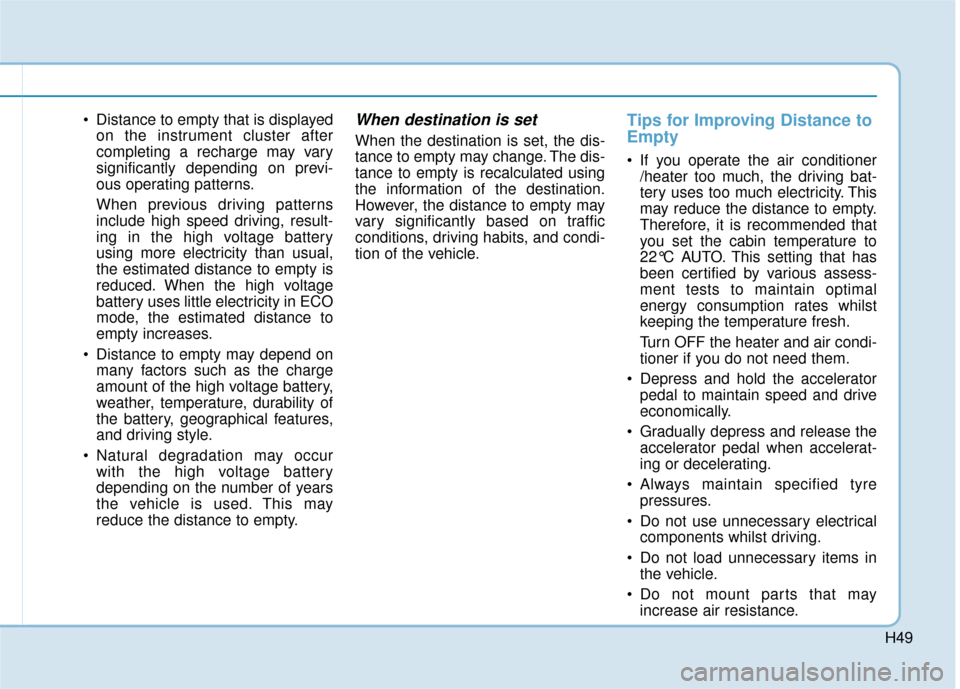Page 8 of 526
H8
E
EV
V
M
M O
OD
DE
E
(
( C
C O
O N
NT
T.
.)
)
Nearby by stations
Stations around the current location
is searched. Depending on the sym-
bol colour of the station, it is catego-
rized as Reachable, Risky and
Unreachable.
Energy Information
You can check battery information
and power consumption.
Battery Information
You can check the reachable range,
total battery power remaining, and
expected charging time for each
charge type.
Electricity Consumption
Power that is consumed by the drive-
train, climate and electrical compo-
nents are displayed.
You can check the current reachable
range when Range and Climate is
turned off.
Page 10 of 526
H10
E
EV
V
M
M O
OD
DE
E
(
( C
C O
O N
NT
T.
.)
)
Set Departure and Climate Off-peak Time Settings
EV Settings
Warning
You can select or deselect the
Range Warning.
- Range Warning : If the destination
set in the navigation cannot be
reached with the. remaining battery,
a warning message is displayed.Description
1Set anticipated departure time after
charging
2Set temperature inside the vehicle
3Select the day of the week you wish
to charge your vehicle
Description
1
If selected, starts charging only on
the designated off-peak time
If deselected, starts charging only on
the scheduled time
2Set the most inexpensive time to start
charging
3Set the most inexpensive time to
complete charging
Page 23 of 526
H23
10. After charging has started, theestimated charging time is dis-
played on the instrument cluster
for about 1 minute.
If you open the driver seat door
whilst charging, the estimated
charging time is also displayed
on the instrument cluster for
about 1 minute.
When scheduled charging is set, the estimated charging time is
displayed as “--" .
Information
Depending on the condition and dura-
bility of the high voltage battery,
charger specifications, and ambient
temperature, the time required for
charging the battery may vary.
Unlock Charging Door in Emergency
If the charging door does not open
due to battery discharge and failure
of the electric wires, open the tail-
gate and slightly pull the emergency
cable as shown above. The charging
door will then open.
i
OAEE046010
OAEE046193L
Page 32 of 526
H32
Trickle Charge
(1) Code and Plug (Code set)
(2) Control Box
(3) Charging Cable and Charging
Connector
Trickle Charge can be used when
Normal Charge or Fast Charge is not
available by using household elec-
tricity.
How to set the charge level of the portable charger
1. Check the rated current of the
electric outlet prior to connecting
the plug to the outlet.
2. Connect the plug to a household electric outlet.
3. Check the display window on the control box. 4. Press the button (1) on the back of
the control box for more than 1
second to adjust the charge level.
(Refer to charging cable type and
example for setting the charge
level.)
C C H
H A
AR
RG
G I
IN
N G
G
E
E L
LE
E C
CT
T R
R I
IC
C
V
V E
EH
H I
IC
C L
LE
E
(
( T
T R
R I
IC
C K
K L
LE
E
C
C H
H A
AR
RG
G E
E)
)
OAEEQ016042
■
Portable Charger
OAEEQ018083
OLFP0Q5020K
PlugElectric Outlet
Page 33 of 526
H33
5. The display window on the controlbox changes from H and M to L
every time you press the button
(1).
6. When setting the charge level is complete, start charging accord-
ing to the trickle charge procedure.* Example for setting the ICCB charge level(The example is only for reference and may vary according to the surround-
ing environment.)
Outlet currentICCB charge
levelControl box display window
14-16A12A
13-12A10A
11-10A8A
9-8A6A
Page 37 of 526
H37
Information
• Even though charging is possiblewith the POWER button in the
ON/START position, for your safe-
ty, start charging when the POWER
button is in the OFF position and
the vehicle shifted to P (Park).
After charging has started, you can
use electrical components such as
the radio by pressing the POWER
button to ACC or ON position.
• During charging, the gear cannot be shifted from P (Park) to any other
gear. 12. After charging has started, the
estimated charging time is dis-
played on the instrument cluster
for about 1 minute.
If you open the driver seat door
whilst charging, the estimated
charging time is also displayed on
the instrument cluster for about 1
minute.
When scheduled charging is set, the estimated charging time is
displayed as “--" .
Information
Depending on the condition and dura-
bility of the high voltage battery,
charger specifications, and ambient
temperature, the time required for
charging the battery may vary.
ii
OAEE046193L
Page 48 of 526

H48
D
DR
RI
IV
V I
IN
N G
G
E
E L
LE
E C
CT
T R
R I
IC
C
V
V E
EH
H I
IC
C L
LE
E
(
( C
C O
O N
NT
T.
.)
)
Distance to Empty
The distance to empty is displayed
differently according to the selected
drive mode in the Drive Mode
Integrated Control System.
For more information, refer to “Drive
Mode Integrated Control System” in
chapter 5.
When destination is not set
On average, a vehicle can drive about 120 miles (191 km). Under
certain circumstances where the
air conditioner/heater is ON, the
distance to empty is impacted,
resulting in a possible distance
range from 80~180 miles
(130~290 km). When using the
heater during cold weather or driv-
ing at high speed, the high voltage
battery consumes a lot more elec-
tricity. This may reduce the dis-
tance to empty significantly.
After “---” has been displayed, the vehicle can drive an additional 2~5
miles (3~8 km) depending on driv-
ing speed, heater/air conditioner,
weather, driving style, and other
factors.
OAE048475N/OAEE047126R
■ NORMAL/
ECO mode selected■SPORT mode selected
The vehicle does not generate
a sound. Be aware of your
driving environment and drive
safely.
After you park the vehicle or
whilst you are waiting at a
traffic light, check whether
there are children or obsta-
cles around the vehicle.
Check if there is something
behind the vehicle when driv-
ing in reverse. Pedestrians
may not hear the sound of the
vehicle.
CAUTION
Page 49 of 526

H49
Distance to empty that is displayedon the instrument cluster after
completing a recharge may vary
significantly depending on previ-
ous operating patterns.
When previous driving patterns
include high speed driving, result-
ing in the high voltage battery
using more electricity than usual,
the estimated distance to empty is
reduced. When the high voltage
battery uses little electricity in ECO
mode, the estimated distance to
empty increases.
Distance to empty may depend on many factors such as the charge
amount of the high voltage battery,
weather, temperature, durability of
the battery, geographical features,
and driving style.
Natural degradation may occur with the high voltage battery
depending on the number of years
the vehicle is used. This may
reduce the distance to empty.When destination is set
When the destination is set, the dis-
tance to empty may change. The dis-
tance to empty is recalculated using
the information of the destination.
However, the distance to empty may
vary significantly based on traffic
conditions, driving habits, and condi-
tion of the vehicle.
Tips for Improving Distance to
Empty
If you operate the air conditioner/heater too much, the driving bat-
tery uses too much electricity. This
may reduce the distance to empty.
Therefore, it is recommended that
you set the cabin temperature to
22°C AUTO. This setting that has
been certified by various assess-
ment tests to maintain optimal
energy consumption rates whilst
keeping the temperature fresh.
Turn OFF the heater and air condi-
tioner if you do not need them.
Depress and hold the accelerator pedal to maintain speed and drive
economically.
Gradually depress and release the accelerator pedal when accelerat-
ing or decelerating.
Always maintain specified tyre pressures.
Do not use unnecessary electrical components whilst driving.
Do not load unnecessary items in the vehicle.
Do not mount parts that may increase air resistance.